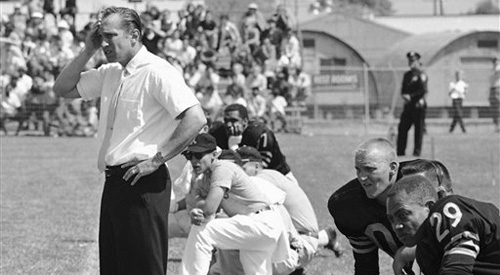
What you need to know about Al Davis and the AFL
Plenty of tributes to former Oakland Raiders owner Al Davis have sprung up since his Oct. 8 death, but most have focused on his time with the franchise and the franchise alone. Though there’s no dispute that his impact on the organization was important, one of the most interesting aspects of Davis’ long tenure in football has been largely passed over as a result.
That would be his time with the old American Football League (AFL) as a coach, general manager and league commissioner, which helped pave the way for the modern era of football.
After picking up an English degree at Syracuse and Wittenburg University in the late 1940s, the Brooklyn native went straight into coaching. He started as the offensive line coach at tiny Adelphi College in 1950, before moving on to become the head coach of an Army team at Fort Beauvoir, Virginia. He was then involved in coaching the offensive line and recruiting at both The Citadel and USC before he took a job working under legendary coach Sid Gillman with the AFL’s Los Angeles Chargers, who moved to San Diego during his tenure. Davis was then named the new head coach and general manager of the Oakland Raiders following the 1962 season. It was a sizeable risk, consider at just 33 years old he was the youngest man ever to hold both positions.
Oakland’s gamble, however, paid off.
Implementing aggressive vertical passing strategies derived from Gillman’s offense, Davis took the team to a 10-4 mark in 1963, the first winning record in franchise history. He was named the AFL’s coach of the year that season. The Raiders regressed a bit the next year, dropping to 5-7-2, but rebounded again to 8-5-1 in 1965. That would be Davis’ last season as an AFL head coach, but not for typical reasons.
[php snippet=1]
Davis wasn’t fired; nowhere close to it. Instead, he was picked to be the AFL commissioner, replacing Joe Foss. At the helm, Davis fundamentally changed the AFL’s strategy. Previously, the league had occasionally fought with the NFL over college prospects, but had ignored players already on NFL rosters. Davis established a much more confrontational relationship, targeting players already in the NFL, and brought seven NFL quarterbacks to the AFL in just two months. That elevated the AFL to the level of serious threat to the NFL, but it didn’t go over well with all of the AFL owners.
Davis’ strategy wound up essentially forcing an AFL-NFL merger on two different fronts. On one level, he made it very expensive and difficult for the NFL to compete with the AFL, dramatically increasing the gains for the NFL in a merger. He also helped boost the AFL’s already impressive quality of talent, making the Super Bowl clash and the eventual merger more feasible.
The other front was less desirable, though. Davis’ strategies made life more expensive for AFL owners too, and convinced several of them to go behind his back and work out the merge deal. The merger likely wouldn’t have happened the way it did if not for Davis’ actions, but it wasn’t his intention. He was out to conquer and destroy the NFL, not join it. The lingering resentment he held against the other AFL owners and the NFL explains much of his renegade character afterwards, and is why characterizations of him as a supervillain can be pretty apt.
The AFL remains a vital part of the history of American football, and it shouldn’t be forgotten. The league is still the only competitor ever to go head-to-head with the NFL successfully, and it merged on quite favorable terms. It also brought in many innovations, including color television broadcasts, shared television contracts, player names on jerseys, stadium scoreboard clocks, two-point conversions, passing-focused offenses, 14-game schedules and the Super Bowl itself.
Davis was a crucial part of the AFL’s history and his actions led directly to the AFL-NFL merger, even if that wasn’t his ideal outcome. His AFL period includes many of his most important achievements, and it shouldn’t be overlooked by all the focus on what he did later.
[php snippet=1]

